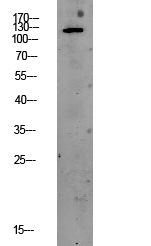PEK/PERK Polyclonal Antibody
- Catalog No.:YT6126
- Applications:WB;ELISA
- Reactivity:Human;Mouse;Rat
- Target:
- PERK
- Fields:
- >>Mitophagy - animal;>>Autophagy - animal;>>Protein processing in endoplasmic reticulum;>>Apoptosis;>>Non-alcoholic fatty liver disease;>>Alzheimer disease;>>Parkinson disease;>>Amyotrophic lateral sclerosis;>>Prion disease;>>Pathways of neurodegeneration - multiple diseases;>>Hepatitis C;>>Measles;>>Herpes simplex virus 1 infection;>>Lipid and atherosclerosis
- Gene Name:
- EIF2AK3 PEK PERK
- Protein Name:
- Eukaryotic translation initiation factor 2-alpha kinase 3 (EC 2.7.11.1) (PRKR-like endoplasmic reticulum kinase) (Pancreatic eIF2-alpha kinase) (HsPEK)
- Human Gene Id:
- 9451
- Human Swiss Prot No:
- Q9NZJ5
- Mouse Swiss Prot No:
- Q9Z2B5
- Rat Gene Id:
- 29702
- Rat Swiss Prot No:
- Q9Z1Z1
- Immunogen:
- Synthesized peptide derived from human PEK/PERK Polyclonal
- Specificity:
- This antibody detects endogenous levels of PEK/PERK.
- Formulation:
- Liquid in PBS containing 50% glycerol, 0.5% BSA and 0.02% sodium azide.
- Source:
- Polyclonal, Rabbit,IgG
- Dilution:
- WB 1:500-2000, ELISA 1:10000-20000
- Purification:
- The antibody was affinity-purified from rabbit antiserum by affinity-chromatography using epitope-specific immunogen.
- Concentration:
- 1 mg/ml
- Storage Stability:
- -15°C to -25°C/1 year(Do not lower than -25°C)
- Other Name:
- Eukaryotic translation initiation factor 2-alpha kinase 3 (EC 2.7.11.1) (PRKR-like endoplasmic reticulum kinase) (Pancreatic eIF2-alpha kinase) (HsPEK)
- Observed Band(KD):
- 130kD
- Background:
- The protein encoded by this gene phosphorylates the alpha subunit of eukaryotic translation-initiation factor 2, leading to its inactivation, and thus to a rapid reduction of translational initiation and repression of global protein synthesis. This protein is thought to modulate mitochondrial function. It is a type I membrane protein located in the endoplasmic reticulum (ER), where it is induced by ER stress caused by malfolded proteins. Mutations in this gene are associated with Wolcott-Rallison syndrome. [provided by RefSeq, Sep 2015],
- Function:
- catalytic activity:ATP + a protein = ADP + a phosphoprotein.,disease:Defects in EIF2AK3 are the cause of Wolcott-Rallison syndrome (WRS) [MIM:226980]; also known as multiple epiphyseal dysplasia with early-onset diabetes mellitus. WRS is a rare autosomal recessive disorder, characterized by permanent neonatal or early infancy insulin-dependent diabetes and, at a later age, epiphyseal dysplasia, osteoporosis, growth retardation and other multisystem manifestations, such as hepatic and renal dysfunctions, mental retardation and cardiovascular abnormalities.,domain:The lumenal domain senses perturbations in protein folding in the ER, probably through reversible interaction with HSPA5/BIP.,enzyme regulation:Perturbation in protein folding in the endoplasmic reticulum (ER) promotes reversible dissociation from HSPA5/BIP and oligomerization, resulting in transautophosphorylation and kinase act
- Subcellular Location:
- Endoplasmic reticulum membrane; Single-pass type I membrane protein.
- Expression:
- Ubiquitous. A high level expression is seen in secretory tissues.
Shikonin potentiates therapeutic efficacy of oxaliplatin through reactive oxygen species-mediated intrinsic apoptosis and endoplasmic reticulum stress in oxaliplatin-resistant colorectal cancer cells DRUG DEVELOPMENT RESEARCH Yajie Zhang WB Human,Mouse HCT116R-xenograft OXA-resistant CRC cells (HCT116R)
Treponema pallidum recombinant protein Tp0768 enhances the ability of HUVECs to promote neutrophil chemotaxis through TLR2/ER stress signaling pathway JOURNAL OF LEUKOCYTE BIOLOGY Cao Ting WB Human 1:1000 human umbilical vein endothelial cells (HUVECs)
- June 19-2018
- WESTERN IMMUNOBLOTTING PROTOCOL
- June 19-2018
- IMMUNOHISTOCHEMISTRY-PARAFFIN PROTOCOL
- June 19-2018
- IMMUNOFLUORESCENCE PROTOCOL
- September 08-2020
- FLOW-CYTOMEYRT-PROTOCOL
- May 20-2022
- Cell-Based ELISA│解您多样本WB检测之困扰
- July 13-2018
- CELL-BASED-ELISA-PROTOCOL-FOR-ACETYL-PROTEIN
- July 13-2018
- CELL-BASED-ELISA-PROTOCOL-FOR-PHOSPHO-PROTEIN
- July 13-2018
- Antibody-FAQs
- Products Images

- Western blot analysis of CACO2 lysate, antibody was diluted at 1000. Secondary antibody(catalog#:RS0002) was diluted at 1:20000

.jpg)